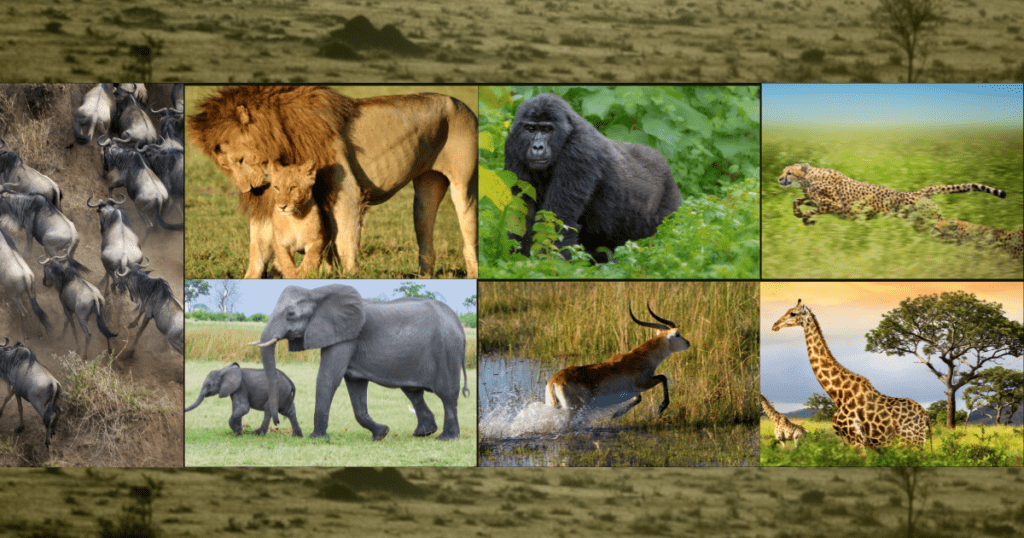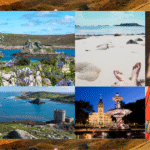Table of Contents
Introduction:
Africa is a land of numerous wonders.Traveling in Africa could be an utterly mesmerizing journey filled with wonders of safaris filled with the diverse beauty of vivid landscapes, rich cultural amalgamation, and unforgettable wildlife encounters.
From the vast savannas of Kenya to the deep, dense jungles of the Congo, each safari holds promises of awe-inspiring moments that linger in the minds of travel enthusiasts forever. Africa’s wildlife is renowned for its diversity and majesty, offering visitors the world’s most iconic creatures that beckon adventurers and nature enthusiasts alike to enjoy unparalleled biodiversity amid vivid cultural amalgamation.
All epic wildlife encounters are not only thrilling but also allow you to indulge in a deeper connection with nature.
Imagine yourself witnessing the thunderous migration of wildebeest across the Serengeti, encountering mammoth African elephants in the dense Okavango Delta, or observing the regal lions roaring in pride by taking complete command and ruling Chobe National Park upfront.
As an enthusiastic globetrotter, exploration can go beyond observation. African safari is about forging a deeper connection with nature and understanding the intricate web of life that flourishes in African soil.
Each encounter in Africa is epic and a story, a powerful example of the delicate balance between humanity and the natural world that sustains them in their habitat without destabilizing any global balance.
As we delve deeper and develop detailed, awe-inspiring African expedition experiences by learning detailed insight into conservation efforts, challenges facing the magnificent creatures, and their profound impact that can disturb our global ecosystems, prepare to be inspired by Africa’s vast landscape and unveil the wonders of Africa in a thrilling journey through the pathways of a diverse continent where we discover the wild calls, extraordinary wildlife encounters, resonance that touches the soul and the profound lessons they impart to you.
Majestic Lions of the Serengeti:
The Serengeti National Park of Tanzania is home to the largest lion population in Africa. This iconic national park is famous with the king of beasts, none other than the lion, along with other wild and unique creatures. Witnessing the pride of the divine creation of nature in their natural habitat, their golden coats shimmering in the African sun is a sight that embodies both power and grace. Imagine hearing the mighty roars echoing across the mammoth savanna in an attempt to strategize a hunt or bond within their social structure.
Serengeti National Park, a UNESCO World Heritage Site in Tanzania, is a home of majestic creatures that embody the raw beauty and power of the African grassland and highlight complex dynamics and the power of nature. Serengeti has some scintillating facts about lions that are bound to fascinate wildlife enthusiasts worldwide.
One of the last strongholds of Serengeti National Park is that it holds approximately 3000 varieties of wild beasts, and around 25 percent of the continent represents the lion population. The ecosystem of Serengeti National Park features a wide variety of wildlife, such as zebras, gazelles, and numerous large herds of wild beasts, which makes Serengeti a favorite hunting ground for apex predators.
One of the significant beauties of Serengeti is the great migration, where a spectacular caravan of animal kingdoms occupied this huge savanna where millions of wildebeest, zebras, and gazelles moved across the Serengeti-Mara ecosystems. This large migration happens annually, adding spectacle to the eyes and a moment to enjoy the mouth-tasting feast for the lion kingdom, where they have many delicious ways to fulfill their appetite.
One of the significant things to note is that during migration, lions are strategically positioned along the migratory routes, taking advantage of the zillions of hoofed mammals crossing their territories and attacking them by positioning themselves well.
The dramatic seasonal shift of animals can impact significant behavioral changes in lions hunting patterns, where their eyes are led up by seeing numerous opportunities to hunt and enjoy delicious meals during this seasonal transition.
Lions have the unique gift of producing a variety of vocalizations, but their roars remain the most distinctive signature style that makes their presence felt in an impactful way. When a lion roars, it will travel up to 8 kilometers in the air through the Serengeti Park’s mammoth open landscapes.
The dominant roars of lions have many purposes: they mark their territory, communicate with other pride members of the lion family, and significantly send a clear message to intimidate rivals. The lion roars are not only the signature sound of Serengeti but also an essential tool in their social interaction.
Unlike other big cats, lions are highly social and love to live in groups called pride. A typical Serengeti consists of correlated females, their offspring, and a combination of males.
Female lionesses often hunt together, armoring sophisticated techniques from their sleeves to hunt down the prey while male lions protect their territory and offspring.
Conservationists are working tirelessly to protect Serengeti lions from significant challenges such as human-wildlife conflict, habitat loss, and poaching, which are ongoing threats that are crucial to be addressed. Conservationists are mitigating these issues through anti-poaching initiatives, community education programs, and habitat restoration projects.
Organizations like the Serengeti Lion Project are crucial in monitoring lion populations and ensuring effective strategies by providing a safe terminal for the long-term survival of lions. Their grandeur, combined with the challenges they faced daily for survival, makes them a focal point and equally significant to be included in Serengeti National Park’s lion conservation efforts. In African folklore, the lion is a symbol of strength, courage, and leadership.
The Serengeti lions are not only an essential asset to this preservation center but crucial to local ecosystems that carry cultural significance, inspiring countless stories to be penned down and providing artistic legends with a platform to sketch out magnificent artworks that will inspire enthusiastic travelers to gain detailed insight into Serengeti National Park’s wildlife nature.
By spreading social awareness, people will realize the importance of preserving the royal creature so that their future generation can survive in their natural habitat, and our future generation has so many things to witness and to be delighted with.
Serengeti attracts millions of tourists each year. It is significant to note that responsible tourism plays a crucial role in lion conservation, and Serengeti wildlife tourism provides vital funds for conservation efforts while raising awareness about the significance of preserving lion habitats.
By practicing ethical wildlife viewing, we ensure that the natural behavior of majestic animals is not disturbed and help to maintain a steady balance in the Serengeti ecosystem.
Lastly, we would like to conclude that the Serengeti lions are more than just an iconic symbol of Tanzania but an integral part of the African wilderness that balances one of the world’s most famous ecosystems.
By learning the art of safeguarding all the magnificent creatures worldwide, we aim to support wildlife conservation and contribute to their survival while celebrating their unmatched beauty by offering endless fascination for nature lovers worldwide at Serengeti, which will remain untamed.
Gentle Giants, Gorilla Trekking in Uganda:
If you seek a unique travel experience that combines natural wonder with meaningful impact, then gentle giants of Uganda await to entertain you in the lap of humble hospitality.
Gentle Giants is a gorilla trekking tour that involves searching for mountain gorillas in their natural habitat. Nestled in the heart of East Africa, Uganda is a land of breathtaking landscapes and unparalleled wildlife encounters that will offer you an awe-inspiring experience.
Amid its mammoth landscapes occupied by myriad treasures, one significant experience that stands out is the extraordinary, sharply moving gorilla trekking pathways in the gateways of dense forests. Embark on a journey through the misty Bwindi Mountains of Uganda, the impenetrable forest, and the Virunga Volcanoes in Rwanda to encounter strong and fierce mountain gorillas.
Meeting these gentle but deadly giants in their lush, forested homes is a humbling experience while pressing the importance of conservation efforts and the necessity of protecting these endangered species. The adventure excursion towards the exciting landscapes of Uganda offers an intimate glimpse into the challenging lives of majestic mountain gorillas by allowing you to learn the importance of supporting the real cause of conservation efforts, which becomes crucial with the growing change in environmental dynamics.
Gorilla trekking in Uganda is considerably safe, as forest wildlife authorities and conservation organizations have taken measures to ensure the safety of the visitors during the trek. So, embark on a journey that combines natural wonder with meaningful impact, where the gentle giants of Uganda are waiting to offer you a life-changing experience.
Mountain gorillas are among the most endangered species on the planet, with fewer than a thousand individuals left in the world. This magnificent creature straddles the borders of Uganda, Rwanda, and the Democratic Republic of the Congo while spending their lives in the mist-covered forests of the Virunga Mountains, stabilizing themselves in the natural habitat of dense jungles.
Uganda remains the premier destination for gorilla trekking due to its world-class conservation efforts and the scintillating terrain of Bwindi and Mgahinga Gorilla National Park.
The Republic of Uganda is adamant and committed to preserving the rights of mountain gorillas, a signature testament and a positive step forward towards effectual conservation measure efforts. The country has seen a significant rise in gorilla populations in recent years thanks to its rigorous anti-poaching efforts and significant community-based conservation measures.
So, do remember that when you embark on gorilla trekking in Uganda, you are directly supporting these efforts and contributing towards the protection and securing the future of these incredible, humble animals.
The trekking experience in Uganda is extraordinary. Bwindi Impenetrable National Park, a UNESCO World Heritage Site, is a verdant ancient rainforest that cuddles visitors in its lush, serene gardenia.
Visitors have plenty of opportunities to develop a sense of discovery and adventure through the pathways of dense foliage and rugged terrain. Each trek is led by experienced, seasoned guides who provide deep insight into gorilla behavior, the ecology system, their movements, and the daily challenges they face.
But at the end of the day, the thrill of finding a gorilla amidst dense forest remains exhilarating and humbling.
Beyond gorilla trekking, visitors can take a deep dive into its rich tapestry of wildlife and natural beauty. From the sparkling waters of Lake Bunyonyi to the sparkling greeneries of Queen Elizabeth National Park, there is no shortage of fun and incredible landscapes with unlimited wildlife encounters to savor. Bird lovers will find Uganda a bewildering place, with thousands of vivid species flys stationed there every year.
Gorilla trekking requires a bit of preparation. Permits must be booked in advance, as they are in high demand. Each trek is limited to a small number of visitors to minimize impact on the gorillas and ensure a quality experience. Ensure you’re in good physical condition, as treks can range from a couple of hours to a full day, depending on the location of the gorilla family.
Gorilla trekking requires a bit of preparation. Permits must be booked in advance, as such an adventure is in high demand. Each trek is limited to a small number of crowds to minimize the human presence impact on gorillas and ensure a quality experience for visitors. Ensure that you are in good physical condition, as treks can be tiring and continue for a couple of hours or even a full day, depending on the location where you can witness the gorilla family.
Once you locate the gorilla family, the experience is nothing short of magical. You can observe the surprising behavior of this gentle giant in their natural habitat, where they display a wide range of attributes such as playing, eating, or simply resting. Give yourself those rare moments to laugh and relax about the entire proceedings. Remember to maintain a safe distance, avoid eye contact, and ensure that the noise is as low as possible.
Revenue from trekking has far-reaching benefits, as tourism supports local communities to grow and develop through education, healthcare, and infrastructure projects. The funds generated from tourism propel conservation initiatives that protect gorillas and keep them safe in their habitats. Each of your contributions is a positive step towards building a conservation cycle for community development.
Gorilla trekking in Uganda offers promising journeys that will leave you in awe and inspired but also make a tangible difference in your life. It does not matter whether you are an avid traveler, a wildlife enthusiast, or a person who is seeking an exciting adventure extravaganza from a meaningful kaleidoscope; the gentle, power-packed giants of Uganda are ready to welcome you into their territory.
Elephant encounters in Botswana’s Okavango Delta:
The Okavango Delta is the home of thousands of African elephants. They migrate from various regions of Okavango, Linyanti, Savute, and Chobe.
The Okavango Delta is a sanctuary famed for elephants, where they roam freely across vast floodplains and lush islands. Witnessing these mammoth and intelligent giants rule the forest as they navigate waterways and nurture their offspring offers a profound insight into their strong familial bonds and flaunting their complex social behavior.
Imagine a sprawling wetland, teeming with playful wildlife, where the air is filled with the sounds of trumpeting elephants floating in the air through the mammoth lush landscapes that shimmer under the glittering African sun. Botswana’s Okavango Delta is one of the world’s most extraordinary destinations for enjoying wildlife extravaganzas.
Okavango Delta is an African jewel where you have the opportunity to witness elephant encounters from a sighting distance and add extra narratives to your African Safari delight, where you can be a testimony of a transformative journey in the heart of the world’s most extraordinary wilds.
The Okavango Delta is unique; it is an inland area located in northern Botswana. The significant beauty of the Okavango delta is that, unlike most deltas, it does not drain into an ocean or sea but spreads towards the Kalahari Desert by creating a vast oasis of life.
This UNESCO World Heritage site is renowned for its rich biodiversity and complex ecosystems, where seasonal floods transform the mammoth lush landscapes into a fusion of water channels, lagoons, and abundant flood points.
Since the Okavango Delta is the home of the largest elephant population in Africa, elephants feel at home and secure in a natural habitat at the arch of this majestic sanctuary. Okavango Delta is an environment where animals get plenty of water, a diverse vegetation diet to fulfill their appetite, and ample space to enjoy and grow as a family.
The Delta seasonal flood further enhances the experience by drawing elephants’ and other wildlife’s attention to expand further in this fertile expanse.
Tourism in Batswana is primarily focused on exclusivity and low-impact travel. Many luxury lodges and eco-campuses are strategically placed to offer tourists intimate encounters with nature while minimizing the impact of human footprints in conservative zones by strictly following the philosophy of low-impact travel in the lush savannas of the Okavango Delta.
Experienced guided rangers will allow you to explore the Delta by traditional transport mokoro (dugout canoe), open 4×4 vehicles, and on foot towards the permitted human-accessible areas. Whether you are traveling by transport or taking a long walk, each different perspective will allow you to witness elephants in their natural habitat, promising you an awe-inspiring experience to savor.
Seasonal wonders are one of the unique cycles of the calendar year, offering vivid experiences throughout the year. The period for witnessing large troops of elephants is ideal during the dry season, which will be from May to October. From November to December, the Delta floods dramatically, creating a labyrinth of waterways that curiously attracts migratory birds and other wildlife, which adds a picturesque dimension to your safari.
Approaching elephants in their natural habitat needs respectful practice and awareness so that they do not feel disturbed by any means. Seasoned forest safari guides in Batswana make sure that safe and ethical interactions have been made between the giant and human solaces, so it’s necessary for travelers to follow their instructions and proceed accordingly by understanding the elephant’s behavior.
Do remember that majestic creatures such as elephants can generally be peaceful but can go wild and threatened if they feel provoked or challenged by someone. Okavango Delta is nothing short of a wonder, where if you are lucky enough, you can witness elephants bathing in the water, feeding on reeds, or interacting with their offspring by producing vivid body postures.
Encountering an elephant is nothing short of a feast for the senses. Imagine hearing the triumphant calls of elephants and the vibration in the ground through their movements, and observing their social interactions within the herds.
Botswana is committed to conserving the legal rights to safeguard the security and protection of these giant elephants in the Okavango Delta habitat. So, as a tourist, by participating in eco-friendly tourism, you are supporting the cause of protecting fragile ecosystems and protecting animals among their inhabitants.
The revenue generated from tourism helps fund projects like anti-poaching initiatives, habitat restoration processes, and community outreach programs that ensure the long-term survival of elephants in their natural habitats.
So, embark on an expedition to witness spectacular elephant encounters and join the biggest global conservation effort, which is about one of Africa’s most scintillating wildlife destinations towards the pathways of the Okavango Delta.
The Great Wildebeest Migration of Africa:
The 800-kilometer-long trek of Africa has witnessed one of the mammoth wildebeest herds, the largest mammal migration on the planet. Witness the greatest wildlife spectacle on earth as millions of wildebeest, zebras, and other herbivores traverse via the Serengeti and Maasai Mara ecosystems in search of sufficient greener grassland.
The annual migration includes dangerous river crossings and a golden opportunity for predators to hunt the prey from a sighting distance, so the resilience and instinctual prowess of wildlife of Africa will be put on the sword where the fight for survival is the ultimate challenge.
Prepare to be spellbound and astonished by one of the most awe-inspiring natural migrations on planet Earth, the Great Wildebeest Migration. This breathtaking extravaganza that happens at the arch of raw beauty and the dynamic rhythm of this mesmerizing African wilderness draws the attention of thousands of travelers, photographers, and wildlife enthusiasts worldwide to witness a glimpse of such an anticlimax spectacle.
From the mammoth plains of Serengeti to the lush savannas of the Maasai Mara, this migration is not limited to the journey itself but a splendid gift of nature, which has many moments to cherish and to be excited about.
The wildebeest migration is extraordinary; it is an annual movement that involves 1.5 million wildebeests, accompanied by hundreds of zebras and gazelles.
The mammoth migration happens between the massive circle of Tanzania’s Serengeti National Park and Kenya’s Maasai Mara National Reserve. These animals are driven to change their accustomed territorial place in the quest for water and food, an uphill path and battle of survival, and a test of endurance.
The migration journey has many phases. From January to March, in the perfect nature-rich Serengeti grassland, wildebeests give birth to around 50,000 calves. From April to June, a group of wildlife moves across the expansive plains of Serengeti, where the constant movements of the herds create a mesmerizing eye-dreamer. July to October is the most dramatic phase of this hoofed mammal migration.
The herds face perilous crossings and stiff challenges at the Mara and Grumeti Rivers, famed as crocodile-infested waters. Witnessing these thousands of wildebeests plunging into trouble water is thrilling and heart-stopping. From November to December, the dry session approaches when the herds begin their return journey in the southern direction of the Serengeti planes.
That concludes the complete migration circle of wildebeest, setting the stage for the next migration cycle, which will begin again with a new challenge. For visitors, July and October are the best sessions to witness the dramatic river crossing spectacle of Wildebeest, or January to March when the calving session is in full swing.
Global photographers often make headlines in travel magazines and wildlife documentaries via Discovery, Animal Planet, and social media, significantly contributing to their earning global fame by highlighting the entire scintillating migration process.
Many tours include educational tutorials highlighting the importance of delicate ecosystem balance, which is critical for conservation, as well as understanding the ecology of the Serengeti-Maasai Mara ecosystem and the territorial challenges.
Plan and choose from a wide range of safari options, from luxury lodges to budget-friendly camps that suit your requirements and make your stay pleasant, while you can enjoy your African safari with the utmost delight.
So, embark on a century-long journey to become a testament to the illustrious wildebeest migration and be blessed to be part of a story that unfolded for millennia.
Cheetahs in Action, Namibia’s Etosha National Park:
Cheetahs are the majestic predators of Namibia’s Etosha National Park. Ethosha National Park of Namibia provides mammoth landscapes to cheetahs, the fastest land animals on the planet, to exhibit their unparalleled agility and hunting prowess. Marvel by locking your eyes to witness the lightning-fast sprints and strategic hunts of cheetahs as they navigate from the expansive salt pans to the grasslands in this unique Namibian desert.
Namibia’s Ethos National Park is not famed as a haven for wildlife; it is also a vibrant stage where the drama of nature unfolds daily, leaving a dramatic spectacle to witness for onlookers. Among its diverse residents, the cheetahs stand out as a trademark of grace, power, and sheer speed that thrills.
For wildlife photographers, it is the perfect curtain eraser for picture-perfect photo galleria captures. For nature lovers and wildlife enthusiasts, it is a moment of appreciation and excitement where the spectacular sights of cheetahs in action are a distinctive package that nobody wants to miss.
The ultimate speedsters, like Cheetahs, are capable enough to reach speeds up to 60 to 70 miles per hour in short bursts. Their bodies are built like sleek felines and heavy silky coats suited for fast chases. In Ethosha, through the vast landscapes and open plains, the agility and speed of cheetahs are on full display as they chase down their prey effortlessly by getting the breakthrough efficiently.
Etoshas unique landscapes support diverse ecosystems and provide a magnificent backdrop for cheetah sightings where you can witness the superfast cheetahs in action. The park welcomes a wide range of wildlife, including elephants, rhinos, smaller antelopes, and birds.
Witnessing the thrill of Cheetahs chasing is the most exhilarating experience, as it furnishes their skill-hunting powers. Unlike other big cats, cheetahs rely on stealth and strength, where speed and sharp paw nails are their ultimate weapons to close down prey.
Regarding conservation and challenges in protecting cheetahs, Etosha is facing significant obstacles. Habitat witnessed human-wildlife conflict that led to many losses, a decline in the Cheetah population, and a threat to survival.
But Namibia is determined and confident to safeguard the life of this endangered wildlife by adopting conservation efforts, including anti-poaching measures and habitat protections, which are crucial steps to ensure the future safety of this incredible animal. So, your visit to Ethosa can significantly contribute to conservation initiatives that help shield cheetahs in their natural habitat.
Ethosa is a park that has well-maintained infrastructure, including well-maintained roads and waterholes that enhance incredible wildlife viewing. By observing high-speed cheetahs and their cubs, learning the art of hunting can offer you an unforgettable wildlife experience.
Also, by visiting Ethosa, you can become a brand ambassador, where you are not supporting conservation efforts but promoting sustainable tourism. Future generations can follow in your footsteps and learn to support the cause of protecting cheetahs in their natural environment.
Cheetahs are the ultimate grace of the park in these dramatic landscapes, which makes Ethosa a prime location for wildlife photography.
To make your visit to Etosha memorable, join guided safaris specialized for cheetah tracking. The experts can narrate in detail by providing insights on Cheetah behavior and offering you chances to witness thrilling encounters with Cheetahs. Tourists can stay at any lodges or camps in Etosha, and that ensures that as a tourist, you are ahead of the game to explore the park and its wildlife wonders.
Namibia’s Etosha National Park is a treasure trove for those travel enthusiasts fascinated by cheetahs and their high-octane lifestyle. Whether you are a photographer, a seasoned traveler, or a casual observer, the thrilling sight of cheetahs in action is adrenaline-pumping, leaving a lasting impression in your memory.
Conservation: The Key to Sustaining African Wildlife:
While Africa’s wildlife is undeniably awe-inspiring, the threats they face are just as real.
Poaching, habitat loss, and human-wildlife conflict have put many species at risk.
Conservation efforts are vital, and travelers can contribute significantly by supporting ecotourism and engaging in Africa’s conservation programs which play a crucial role in protecting endangered species and fostering global environmental sustainability.
African wildlife conservation efforts are more deciding than ever, and as travelers, we have a responsibility to contribute to these initiatives.
Rhino and elephant conservation programs focus on reducing poaching and providing a safe sanctuary for endangered species.
Community-based conservation programs empower local communities to coexist harmoniously with wildlife by fostering sustainable living practices, offering economic opportunities through ecotourism, and emphasizing the critical need to protect natural resources.
Wildlife sanctuaries across Africa provide safe havens for orphaned animals, endangered species, and those injured, offering them a second chance at life while shielding them from potential threats posed by wild predators and other dangers to their survival.
By supporting responsible tourism, travelers play an essential role in preserving Africa’s wildlife for future generations.
Supporting wildlife conservation efforts is an essential aspect of your safari experience to ensure that Africa’s extraordinary wildlife continues to thrive as a cornerstone of our planet’s natural wonder and a vital part of sustainable tourism for generations to come.
The Profound Impact of Wildlife on the Human Spirit:
Beyond marveling at the beauty of Africa’s wildlife, witnessing animals in their natural habitat not only evokes a profound sense of wonder but also stirs a deep commitment to protecting them, answering nature’s call for action by bringing inspiring, meaningful change.
Wildlife encounters have the transformative power to shift perspectives, raise awareness about conservation challenges, and galvanize global efforts to safeguard the wildlife future.
Every safari experience is more than just observing wildlife, it is a chance to champion the cause of protecting them and preserving their natural habitats for future generations.
A Life-Changing Journey:
Epic African wildlife encounters offer more than just an adrenaline rush; they are transformative experiences that can deepen our understanding of the world and inspire us to protect it.
Whether you are witnessing the Great Wildebeest Migration, observing lions on a hunt for their prey, or trekking with gorillas in the mist, each moment offers a chance to connect with nature in its rawest form.
The lessons gained from these journeys become lasting pillars of understanding, teaching us resilience, interconnectedness, and the importance of conservation, and schooling that remains deeply ingrained long after the captivating safari concludes.
Essential Insights from Epic African Wildlife, Unforgettable Encounters That Inspire:
The Big Five & Iconic Wildlife: The African Big Five—lion, leopard, elephant, buffalo, and rhinoceros—are more than just the top animals to see; they represent the raw power, beauty, and complexity of nature in one habitat.
Each encounter with these majestic creatures teaches us important lessons about strength, family, and the survival journey of these wild animals amid harsh daily life situations.
Diverse and Stunning Landscapes: Africa’s breathtaking terrains, from the sweeping plains of the Serengeti to the verdant Okavango Delta, provide an idyllic backdrop for unforgettable wildlife encounters amidst nature’s unspoiled beauty.
The unique terrain not only showcases incredible animals but also highlights the delicate balance between conservative ecosystems and sustainable life.
Close, Intimate Encounters: Walking safaris and gorilla trekking provide intimate, life-changing experiences. Being in the presence of wild animals up close allows you to build an emotional bond and a deeper understanding of their effective role in maintaining a stable natural world.
Inspiration for Action: African wildlife has the power to inspire, moving travelers to take an active role in understanding the beauty of the planet’s biodiversity.
Observing these incredible creatures with keen interest motivates people to protect wildlife in their habitats and raise awareness about the significance of conservation.
The Value of Respectful Engagement: A safari is more than just a chance to view wildlife; it is an opportunity to engage responsibly with the environment.
Understanding and respecting local cultures and wildlife laws ensures that we contribute positively to the destinations we visit.
Conclusion:
Exploring Africa’s wildlife is not just about observing wildlife and their behaviors; it is about connecting with nature in its purest form.
Each encounter leaves an indelible mark, an incredible moment to enjoy, fostering a deeper appreciation and understanding of the delicate balance of ecosystems and the urgent need for conservation efforts. Whether you dream of tracking gorillas through dense forests or witnessing the drama of the Great Migration, Africa promises experiences that will inspire and enrich your soul for a lifetime.
Embark on this journey of discovery in the exciting pathways of African safari, and let the magic of Africa’s wildlife unfold before your eyes. By sharing your experience with others after returning home, you can develop cavernous engagement with numerous wildlife enthusiasts passionate about nature and adventure.
FAQs:
What’s the Great Migration, and why is it an epic African wildlife encounter?
The Great Wildebeest Migration in Africa is the world’s colossal wildlife spectacle, where over a million wildebeests, zebras, and antelopes migrate across the Serengeti (Tanzania) to Maasai Mara (Kenya) relocate from their natural habitat to another territory in search of greener pastures. Witnessing this incredible journey is a thrilling experience that is awe-inspiring and full of wonder.
Which African safari destination offers the best chance to see the Big Five (lion, leopard, rhinoceros, elephant, and Cape buffalo) in their natural habitat?
The Maasai Mara National Reserve in Kenya is renowned for its abundant and diverse wildlife, making it one of the best places to spot the Big Five in their natural habitat. With its rolling hills, grasslands, and abundant prey, the Maasai Mara offers an unforgettable safari experience for travel enthusiasts.
What’s the best time to see African elephants in their natural habitat, and why are they so iconic?
The best time to see African elephants is during the dry season from June to October when they congregate around water sources with their offspring. As the largest land animals on Earth, elephants are majestic, intelligent, and social creatures that inspire travelers. Wonders and respect are evident for these giant creatures of Earth.
Can I have a safe and unforgettable encounter with mountain gorillas in Africa?
Yes, guided treks in Rwanda’s Volcanoes National Park or Uganda’s Bwindi Impenetrable National Park offer a unique opportunity to observe mountain gorillas in their natural habitat. With expert guides and safety precautions, you can have a life-changing encounter with these gentle giants and take away a lot of funny and joyful moments that promise to create an erasable memory in your mind.
How can I contribute to conservation efforts while experiencing epic African wildlife encounters?
As a value-added traveler, choose responsible tour operators who support conservation initiatives and promote local communities. Consider visiting protected areas, supporting eco-lodges, and spreading awareness about wildlife conservation. By doing so, you’ll be contributing towards the protection of Africa’s incredible wildlife heritage and leaving positive footprints for future generations to follow in the same footsteps.







